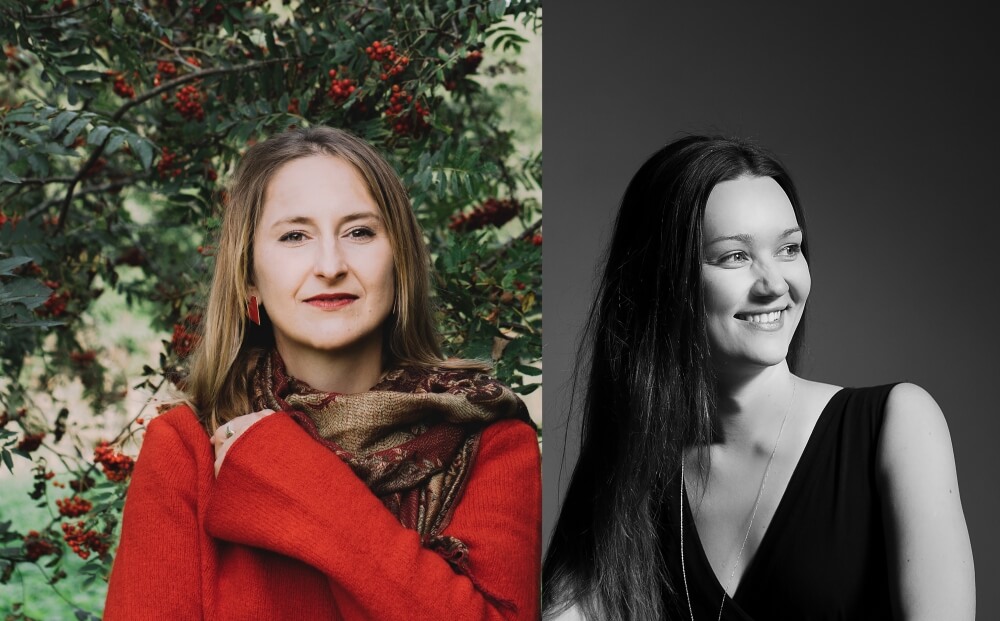
13:00
Tallinn Philharmonic Society House of Blackheads, White Hall
Venue info + map
Ticket 15/10 €
Kadri-Ann Sumera (piano)
Talvi Hunt (piano, electronics)
Madli Marje Sink (b. 1994, Estonia, winner of LHV Au-tasu special award The LHV new music award Au-tasu)
“Dream Sequence of an Ancient Forest” for two pianos and electronics (2019, premiere)
Yulan Qiu (b. 1976, China)
“Butterfly Dance” for piano solo (2013)
Kadri-Ann Sumera (piano)
Miyuki Ito (Japan)
“Étoile Double (IV)” / “Double Star (IV)” for two pianos (2018)
Raimo Kangro (1949–2001, Estonia)
“Retro I” from Sonata for two pianos Op. 28 (1981)
Michal Rataj (b. 1975, Czech Republic)
“Spotless Mind” for piano solo (2014)
Kadri-Ann Sumera (piano)
Douglas Knehans (b. 1957, USA)
“touch” for solo piano and electronics on compact disc (1997–1998/2010)
Talvi Hunt (piano), Tammo Sumera (electronics)
Riho Esko Maimets (b. 1988, Estonia)
“sinikõrgustele” / “infinite blue heights” for two pianos (2019, premiere)
Simon Eastwood (b. 1985, New Zealand)
“Interference” for piano and player inside the piano (2012)
Livia Teodorescu-Ciocănea (b. 1959, Romania)
“Magna Mater. Cybele” for two pianos (2017)
Kadri-Ann Sumera is one of the most outstanding and sought-after Estonian pianists of her generation. She is engaged as soloist as well as chamber musician and accompanist and her repertoire covers a wide range from baroque to contemporary music. She has premiered pieces written for her (for example Piano Concerto of Märt-Matis Lill and “A rebours” by Nicolas Gilbert) and performed on several Estonian premieres of the key works of the 20th century such as Karlheinz Stockhausen’s “Mantra” for two pianos and electronics (with Sabine Simon and Hendrik Manook), Olivier Messiaen’s “Harawi” for soprano and piano (with Kai Kallastu) and John Cage’s “Dances for two prepared pianos” (with Hanna Heinmaa). Sumera has been involved in multimedia performances. Estonian piano music holds an important place in her repertoire, especially the works of her father Lepo Sumera, one of Estonia’s main composer of all times. www.kadriannsumera.eu
Talvi Hunt is a diverse pianist whose main interest lies in interpreting the music of 20th and 21st century. Her performances during the past three years have mostly connected her to Switzerland and Germany. Talvi has played in several music collectives such as Luzerne Symphony Orchestra, Collegium Novum Zürich, Ensemble Ö; she has been regularly invited to play in Stuttgart Chamber Orchestra. Since 2014, Talvi Hunt belongs to Ensemble of Nomad as a pianist and one of the artistic directors. The ensemble mainly focuses on contemporary music including the elements of electronics, video art and theatre. Talvi has collaborated with several known composers such as Helmut Lachenmann, Wolfgang Rihm, Peter Ablinger, Enno Poppe, Michael Wertmüller, Jürg Wyttenbach, Thomas Adès, Unsuk Chin and Michel van der Aa.
House of the Black Heads is one of the oldest and most renowned building complexes in Tallinn’s Old Town. This was the historic home of the Brotherhood of Black Heads, a medieval guild made up of young, single merchants and foreigners. The guild’s patron saint was the Moorish St. Mauritius – a profile of his head is pictured on the Brotherhood’s coat of arms. The Brotherhood itself, which arose sometime around 1399, was active only in Estonia and Latvia, and never took hold in the rest of Europe. It is interesting to note that among the brotherhood’s duties in medieval times was putting Tallinn’s Christmas tree on Town Hall Square each year. Records show that the activity started at least as far back as 1441, making Tallinn the first city in Europe to have the tradition of a public Christmas tree.
The most unique rooms are the White Hall (1532), which is the first venue in Renaissance style in Tallinn, and the St. Olaf’s Guild Hall (1422), built in the late Gothic style.
The long history of the brotherhood is full of legends of saints, soldiers, and adventurers, which are nowadays primarily reflected in the names of the premises. House of the Blackheads, which is located in the historic gathering place of Tallinn’s former merchants and craftsmen’s associations, is frequently used for concerts and other gala occasions.
https://www.filharmoonia.ee/en/mustpeademaja/



